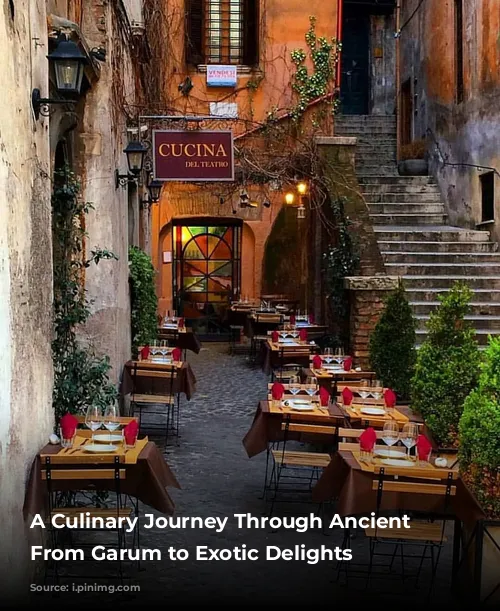Imagine a world where garum, a pungent fermented fish sauce, was the condiment of choice, and silphium, a prized herb, was the star ingredient in countless dishes. Today, we might scoff at the idea of eating these ancient delicacies, but for the Romans, they were staples of their culinary landscape.
The Allure of Garum and Silphium
Garum was a fish sauce produced in factories along the Roman coastline. Imagine the aroma of fermenting anchovies, sun-baked and brimming with umami flavor. This potent condiment found its way into everything, from savory dishes to sweet desserts. Though the idea of fish sauce might seem strange to some, it’s similar to the flavor profiles of Thai and Vietnamese cuisine, where fish sauce plays a prominent role.
The Romans also had a deep appreciation for silphium, an herb so prized that its image graced their coins. This wonder herb, with its leek-like flavor, was used for everything from medicine to birth control. Sadly, due to over-farming, silphium went extinct, leaving us to imagine its unique taste through historical accounts.
Beyond the Ordinary: A Glimpse into Roman Extravagance
While garum and silphium were common in Roman cuisine, the wealthy Romans had access to a world of exotic delicacies, a culinary playground of extravagance and indulgence.
Flamingos, prized for their tongues, were a favorite of Apicius, a renowned Roman gourmand. Peacocks graced the tables of the elite, with their meatballs ranking above pheasant, rabbit, chicken, and even pork. The Romans also embraced the culinary possibilities of cranes, parrots, and songbirds, enjoying them in whole, bone-in dishes.
Dormice were considered a luxury, fattened in special jars and served fried, bones and all. This practice, surprisingly, continues in parts of Croatia and Slovenia today.
The Romans embraced the whole animal, utilizing every part in their cooking. Wombs, tripe, udders, brains, testicles, kidneys, and even sow’s vulva were considered delicacies, reflecting their willingness to explore the full potential of their ingredients.
Ancient Roots of Modern Food
Many of the dishes we enjoy today have their roots in Ancient Rome.
Electric Ray, with its complex marinade of pepper, lovage, parsley, mint, oregano, egg yolk, honey, garum, sweet wine, mustard, vinegar, and even raisins, is a testament to the Romans’ love of flavor combinations.
Bulbs, like onions, garlic, and leeks, were just as common in Roman times as they are today. The Romans even experimented with flower bulbs, often fried and served in a sauce.
Foie gras, though known for its French origin, actually traces back to ancient times. The Romans, inspired by the Egyptians and Greeks, developed a technique of fattening pigs with dried figs and wine, creating a liver rich in flavor.
The Roman snail, a common pet today, was once a culinary delight. Fattened on a mixture of wine and flour, or even milk, they were a testament to the Romans’ desire to indulge in unusual delicacies.
Posca, a simple concoction of red wine vinegar, water, and herbs, was a staple drink for Roman soldiers. It provided fortification and protection against scurvy and bacteria.
A Journey Through the Roman Table
From tapenades to foie gras and fried dough, the Romans embraced a diverse and fascinating range of culinary experiences. They understood the importance of flatbread, a staple that continues to nourish people across the world.
The Romans’ love of eggs is evident in the numerous recipes for patinae, dishes featuring eggs in various forms, from simple omelets to complex, multi-ingredient creations.
Their meals were often elaborate, with multiple courses, and lavish presentation, showcasing their appreciation for both taste and aesthetics.
Today, as we explore the culinary world of Ancient Rome, we can’t help but be amazed by their adventurous spirit and their love of good food. It’s a testament to the enduring power of food to connect us across time and cultures.
